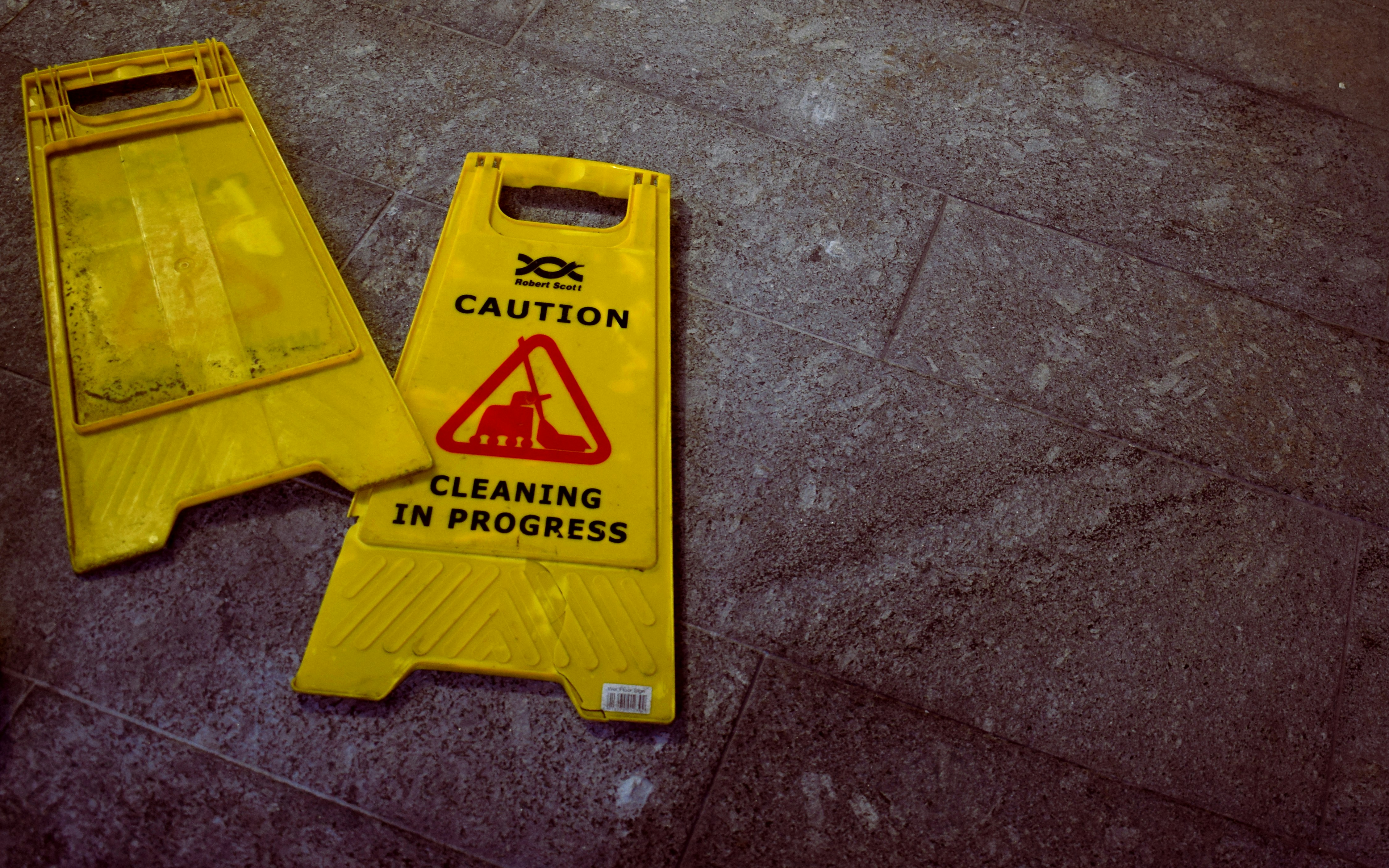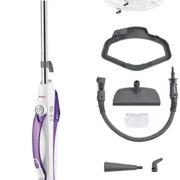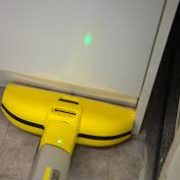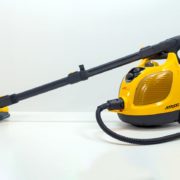In this article, you will learn about the impact that water quality can have on the performance of a steam cleaner. We will explore how different factors such as hardness, pH levels, and impurities in the water can affect the cleaning efficiency and longevity of your steam cleaner.
Firstly, let’s discuss the role of hardness in water. Hard water contains high levels of minerals, such as calcium and magnesium. When using a steam cleaner with hard water, these minerals can build up and form limescale deposits inside the machine. This can clog the heating elements and reduce the steam output, leading to a decrease in cleaning power. By understanding the impact of hard water and taking steps to prevent limescale buildup, you can ensure that your steam cleaner operates at its optimal performance level.
Secondly, let’s talk about the importance of pH levels in the water used for steam cleaning. The pH scale measures the acidity or alkalinity of a substance. Using water with a high or low pH can have negative effects on the effectiveness of your steam cleaner. Extremely acidic or alkaline water can cause corrosion, damage to internal components, and even affect the performance of cleaning solutions. It is crucial to use water with a neutral pH to ensure that your steam cleaner functions properly and achieves the desired cleaning results.
By understanding the impact of water quality on steam cleaner performance, you can take the necessary steps to optimize the efficiency and longevity of your machine. From monitoring hardness levels to maintaining a neutral pH, these small adjustments can make a big difference in the effectiveness of your steam cleaning efforts. Choose the right water for your steam cleaner, and enjoy the benefits of a clean and sanitized environment.
Introduction
Water quality plays a crucial role in the performance of steam cleaners. These powerful machines rely on high-quality water to produce efficient and effective steam for cleaning and sanitizing various surfaces. Understanding the relationship between water quality and steam cleaner performance is essential for maintaining optimal functionality and achieving desired cleaning results.
Definition of Water Quality
Water quality refers to the chemical, physical, and biological characteristics of water, including its purity, pH level, mineral content, and presence of impurities. High-quality water is essential for various applications, including drinking, agriculture, and industrial processes. In the context of steam cleaners, water quality directly impacts the machine’s ability to generate and deliver steam effectively.
Importance of Steam Cleaner Performance
Steam cleaners have become increasingly popular due to their versatility and effectiveness in cleaning and sanitizing various surfaces. Whether used for household or commercial purposes, steam cleaners can remove dirt, grime, and bacteria without the need for harsh chemicals. Therefore, ensuring optimal steam cleaner performance is crucial for achieving efficient and hygienic cleaning.
Link Between Water Quality and Steam Cleaner Performance
The quality of water used in steam cleaners directly affects their performance and longevity. Water that is contaminated or contains high levels of minerals and impurities can cause issues such as clogged nozzles, reduced steam pressure, and lower steam temperature. Understanding the factors that affect water quality and their impact on steam cleaners is essential for maintaining and enhancing their functionality.
Factors Affecting Water Quality
Several factors contribute to water quality, each playing a significant role in the performance of steam cleaners. Understanding these factors will help you identify the potential issues that may arise due to poor water quality.
Chemical Composition of Water
Water contains various chemicals, including dissolved gases, organic and inorganic substances, and minerals. The chemical composition of water can vary depending on its source and treatment process. High levels of certain chemicals, such as chlorine and fluoride, can affect the performance of steam cleaners and potentially damage their internal components.
Presence of Minerals and Impurities
Water often contains minerals, including calcium, magnesium, iron, and manganese, which can have a significant impact on steam cleaner performance. These minerals can accumulate in the machine over time, leading to the formation of limescale, clogging of nozzles, and reduced steam production. In addition to minerals, impurities such as sediments, dirt, and organic matter can also affect water quality and steam cleaner performance.
pH Level of Water
The pH level of water indicates its acidity or alkalinity. Steam cleaners typically require water with a neutral pH level to ensure optimal performance. Water that is too acidic or alkaline can cause corrosion, damage to internal components, and reduce steam production. Monitoring and adjusting the pH level of the water used in steam cleaners is essential for maintaining their efficiency and longevity.
Hardness and Softness of Water
Water hardness refers to the concentration of minerals, primarily calcium and magnesium, present in the water. Hard water contains high levels of these minerals, while soft water has a lower mineral content. The hardness of water can vary based on the geographic location and source. Hard water can cause mineral buildup in steam cleaners, leading to decreased steam production and higher energy consumption. Softening hard water can help prevent these issues and maintain optimal steam cleaner performance.
Effects of Water Quality on Steam Cleaner Performance
Poor water quality can have several adverse effects on steam cleaner performance. Understanding these effects will help you identify and address potential issues to ensure optimal steam cleaner functionality.
Mineral and Impurity Buildup in the Steam Cleaner
When water containing minerals and impurities is heated in a steam cleaner, these substances can accumulate inside the machine. Over time, mineral and impurity buildup can clog the internal components, such as pipes, valves, and nozzles. This buildup restricts water flow, reduces steam pressure, and affects the overall performance of the steam cleaner.
Clogging of Steam Cleaner Nozzles
Mineral and impurity buildup can also lead to the clogging of steam cleaner nozzles. Clogged nozzles result in uneven steam distribution and reduced cleaning efficiency. Cleaning the nozzles regularly and using high-quality water can help prevent clogging and ensure consistent steam flow for effective cleaning.
Reduction in Steam Pressure
Mineral deposits and impurities in the water can accumulate and create blockages within the steam cleaner’s internal components. These blockages can restrict water flow and reduce steam pressure. Insufficient steam pressure affects the ability of the steam cleaner to remove dirt and grime effectively. Regular maintenance and using water with low mineral content can help prevent pressure loss and maintain optimal steam production.
Decreased Steam Temperature
Water quality also affects the temperature of the steam produced by the cleaner. High mineral content and impurities in the water can reduce the overall steam temperature, impacting the cleaner’s effectiveness in sanitizing surfaces. Maintaining water quality by removing minerals and impurities can help ensure the steam cleaner generates steam at the desired temperature for optimal cleaning and disinfection.
Formation of Limescale
One of the most common issues resulting from poor water quality is the formation of limescale. Limescale is a hard, white deposit that appears when water containing high levels of minerals, particularly calcium and magnesium, is heated. Limescale buildup can occur inside the steam cleaner’s heating element, pipes, and other internal components, reducing its efficiency and lifespan. Regular descaling and using softened water can help prevent limescale formation and prolong the steam cleaner’s longevity.
Testing Water Quality for Steam Cleaners
Testing the water quality used in steam cleaners is essential for identifying potential issues and determining the appropriate measures to improve water quality. Several methods can be used to test water quality for steam cleaners.
Water Quality Testing Kits
Water quality testing kits are readily available in the market and provide a convenient way to assess water composition. These kits typically contain test strips or tubes that change color when exposed to specific elements or chemicals. The results can help determine the pH level, mineral concentration, and the presence of impurities in the water.
Measuring pH Levels
Measuring the pH level of water can be done using pH test strips or electronic pH meters. Steam cleaners typically require water with a pH level close to neutral, around 7. Testing and adjusting the pH level accordingly can help maintain optimal steam cleaner performance.
Determining Water Hardness
Water hardness can be determined by using test strips or electronic hardness testers. These tests measure the concentration of minerals, primarily calcium and magnesium, in the water. Steam cleaners generally perform best with water that has low mineral content, ensuring minimal erosion and limescale formation.
Identifying Mineral Content and Impurities
Laboratory testing can provide a comprehensive analysis of water quality, including its mineral content and impurity levels. This analysis helps identify specific contaminants that may affect steam cleaner performance. Professional water testing services can provide accurate results and recommendations for improving water quality.
This image is property of images.unsplash.com.
Improving Water Quality for Better Steam Cleaner Performance
Improving water quality is essential for ensuring optimal steam cleaner performance. Several methods and techniques can be used to enhance water quality and minimize its adverse effects on steam cleaners.
Water Softening Techniques
Water softening techniques aim to reduce the concentration of minerals, primarily calcium and magnesium, in the water. Water softeners, such as ion exchange systems, remove the hardness-causing minerals and replace them with sodium or potassium ions. Softened water reduces the risk of limescale formation and enhances steam cleaner performance.
Use of Water Filters
Water filters can effectively remove impurities, sediments, and contaminants from the water, improving its quality. Various types of filters, such as activated carbon filters and reverse osmosis systems, are available for different filtration needs. Using water filters ensures cleaner water, reduces mineral buildup, and enhances steam cleaner efficiency.
Water Purification Methods
Water purification methods, such as distillation and reverse osmosis, can significantly improve water quality for steam cleaners. Distillation involves heating water, collecting the steam, and condensing it back into liquid form, removing impurities and minerals. Reverse osmosis uses a semipermeable membrane to filter out contaminants. Both methods provide purified water, minimizing the risk of mineral buildup and improving steam cleaner performance.
Descaling and Maintenance of Steam Cleaners
Regular descaling and maintenance of steam cleaners are crucial for maintaining optimal performance. Descaling involves removing mineral and limescale deposits from the machine using descaling agents or vinegar solution. Following the manufacturer’s instructions and performing routine maintenance tasks, such as cleaning filters and inspecting nozzles, increases the lifespan of the steam cleaner and ensures consistent performance.
Importance of Regular Maintenance
Regular maintenance is essential for ensuring optimal steam cleaner performance and extending its lifespan. By implementing the following maintenance practices, you can maximize the efficiency and effectiveness of your steam cleaner:
Preventing Mineral Buildup
Regular descaling and cleaning of the steam cleaner’s components help prevent mineral buildup in the machine. This maintenance practice ensures consistent steam production and minimizes the risk of clogging and reduced performance.
Cleaning and Unclogging Steam Cleaner Parts
Regularly cleaning and unclogging steam cleaner parts, such as nozzles and hoses, is essential for maintaining optimal steam flow and distribution. Removing any obstructions or debris ensures the machine’s efficiency and prevents uneven steam distribution.
Ensuring Optimal Water Flow and Pressure
Regularly checking the water flow and pressure of the steam cleaner helps identify any issues or blockages that may affect its performance. Ensuring a consistent and adequate water supply enables the machine to produce steam efficiently and deliver optimal cleaning results.
Enhancing Steam Generation and Temperature
Maintaining water quality and regularly cleaning the steam cleaner’s heating element contribute to enhanced steam generation and optimal temperature. This ensures efficient cleaning and sanitization of surfaces, removing bacteria, germs, and stubborn stains effectively.
Benefits of Using High-Quality Water
Using high-quality water in steam cleaners offers several benefits and advantages over using low-quality or contaminated water. These benefits include:
Increased Cleaning Efficiency
High-quality water ensures optimal steam production and distribution, leading to increased cleaning efficiency. The powerful steam can effectively remove dirt, grime, and bacteria from various surfaces without the need for harsh chemicals. Clean surfaces contribute to a healthier and safer environment.
Prolonged Steam Cleaner Lifespan
By using high-quality water, you can minimize mineral buildup, limescale formation, and internal corrosion in the steam cleaner. This extends the machine’s lifespan and reduces the need for frequent repairs or replacements.
Reduced Downtime and Repairs
Poor water quality can result in frequent breakdowns and repairs. By using high-quality water, you can reduce downtime and minimize the need for repairs, ensuring uninterrupted cleaning operations.
Improved Sanitization and Disinfection
High-quality water produces steam with the desired temperature and pressure, allowing for effective sanitization and disinfection of surfaces. This is particularly important in environments that require stringent cleanliness standards, such as healthcare facilities and food establishments.
Considerations for Water Source
The choice of water source for steam cleaners is essential to ensure optimal performance and minimize potential issues. Two primary water sources commonly used are tap water and distilled water.
Tap Water vs. Distilled Water
Tap water is the most accessible and commonly used water source for steam cleaners. However, tap water can vary significantly in terms of its mineral content, impurities, and chemical composition. Using tap water may require additional measures, such as water softening or filtration, to improve its quality and prevent mineral buildup.
Distilled water, on the other hand, undergoes a purification process that removes nearly all impurities and minerals. Using distilled water ensures minimal mineral buildup and limescale formation, contributing to optimal steam cleaner performance. However, distilled water may not always be readily available or cost-effective for daily use in steam cleaners.
Alternative Water Sources
In some cases, alternative water sources may be considered for steam cleaner use. These alternative sources, such as rainwater or well water, may have different mineral compositions and impurity levels. Testing and analyzing the water quality before using alternative sources can help determine the necessary precautions and treatments for optimal steam cleaner performance.
Benefits and Drawbacks of Each Source
Choosing the appropriate water source for your steam cleaner depends on various factors, including water quality, availability, and cost. While tap water is readily available, it may require additional treatments or filtration to ensure optimal performance. Distilled water offers superior water quality but may be less practical for everyday use due to its cost and availability. Considering the benefits and drawbacks of each water source will help you make an informed decision based on your specific needs and circumstances.
Expert Tips for Optimal Water Usage
To ensure optimal water quality and usage for steam cleaners, consider implementing the following expert tips:
Preventing Water Contamination
Store water in clean, sealed containers to prevent contamination from external sources. Avoid cross-contamination by using separate containers for different water sources.
Proper Water Storage and Handling
Store water in a cool, dry place away from direct sunlight and potential contaminants. Avoid prolonged exposure to extreme temperatures, which can affect water quality and steam cleaner performance.
Using the Right Water Temperature
Using water at the appropriate temperature ensures optimal steam production and cleaning efficiency. Follow the manufacturer’s guidelines for the recommended water temperature for your specific steam cleaner model.
Maintaining Water Quality During Storage
If storing water for an extended period, consider using airtight containers or adding preservatives, such as chlorine or hydrogen peroxide. Regularly test the water quality to ensure it is still suitable for steam cleaner use.
Conclusion
Water quality plays a significant role in the performance and longevity of steam cleaners. Factors such as the chemical composition of water, presence of minerals and impurities, pH level, and water hardness directly impact steam cleaner functionality. Understanding the effects of poor water quality and implementing measures to improve and maintain water quality is crucial for achieving optimal cleaning results.
Regular maintenance, such as descaling and cleaning, ensures continuous steam cleaner performance and minimizes the risks of mineral buildup and clogging. Using high-quality water enhances cleaning efficiency, prolongs steam cleaner lifespan, reduces downtime, and improves sanitization and disinfection capabilities.
Considerations for water source, such as tap water or distilled water, depend on factors such as water quality, availability, and cost. Alternative water sources may require additional treatments or analysis before use in steam cleaners. Expert tips for optimal water usage, including preventing contamination, proper storage, and maintaining water quality, further contribute to better steam cleaner performance and overall cleaning effectiveness.
By understanding the impact of water quality on steam cleaner performance and implementing appropriate measures, you can ensure efficient and effective cleaning, prolong the lifespan of your steam cleaner, and maintain a clean and healthy environment.




